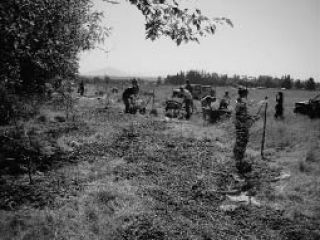MARYSVILLE — A tributary of the West Fork of Quilceda Creek flows from Arlington through Marysville to the Snohomish River on the Tulalip Reservation. It provides a lush green corridor through the density of civilization which has impacted its fish population by low oxygen levels and high fecal coliform levels.
Now, thanks to the efforts of the Adopt-A-Stream Foundation in partnership with Edmonds Community College and the Department of Ecology, Quilceda Creek is on the path to recovery.
As a result of Adopt-A-Stream’s DOE sponsored door-to-door landowner contact in the Quilceda watershed, Paul Cedarland, a small ranch owner with cattle and horses, agreed to allow AASF to create a 35-foot-wide buffer from animals along the stream and install log structures in the stream channel.
Approximately 200 native trees and shrubs were planted in February 2008 by Boy Scout Troop No. 42 along 500 feet of stream channel and more recently, on July 9, more plants, mulch and barriers were added.
Tom Murphy, an anthropology professor at Edmonds Community College, and long-time AASF partner, brought 12 students from his environmental anthropology class to the site to learn about riparian restoration and stream hydrology. Murphy is a strong believer in the importance of placed-based education.
Murphy’s students assisted the AASF crew by spreading 75 cubic yards of mulch, donated by Snohomish County, around the native trees and shrubs, donated by AASF and Snohomish County.
Cascade Coffee donated jute coffee bags that were placed around each tree to act as a weed-barrier to keep pasture grasses and invasive plants from overgrowing the native trees and shrubs.
The students also had the opportunity to use their “hydrologic intuition.” Under direction from AASF, they created and installed log structures in the stream channel. The carefully placed logs will provide in-stream channel complexity and new fish habitat. Water flowing over the logs will also add oxygen to the water necessary for fish life. Once the native trees have grown up, they too will play an important role in shading the creek and preventing soil erosion.
The new streamside vegetation area is fenced and Cedarland’s horses and cattle will be staying out of Quilceda Creek in the future, preventing future pollution problems in this part of the creek.
Property owners who would like similar stream restoration assistance in the Quilceda Creek watershed should call 425-316-8592.



